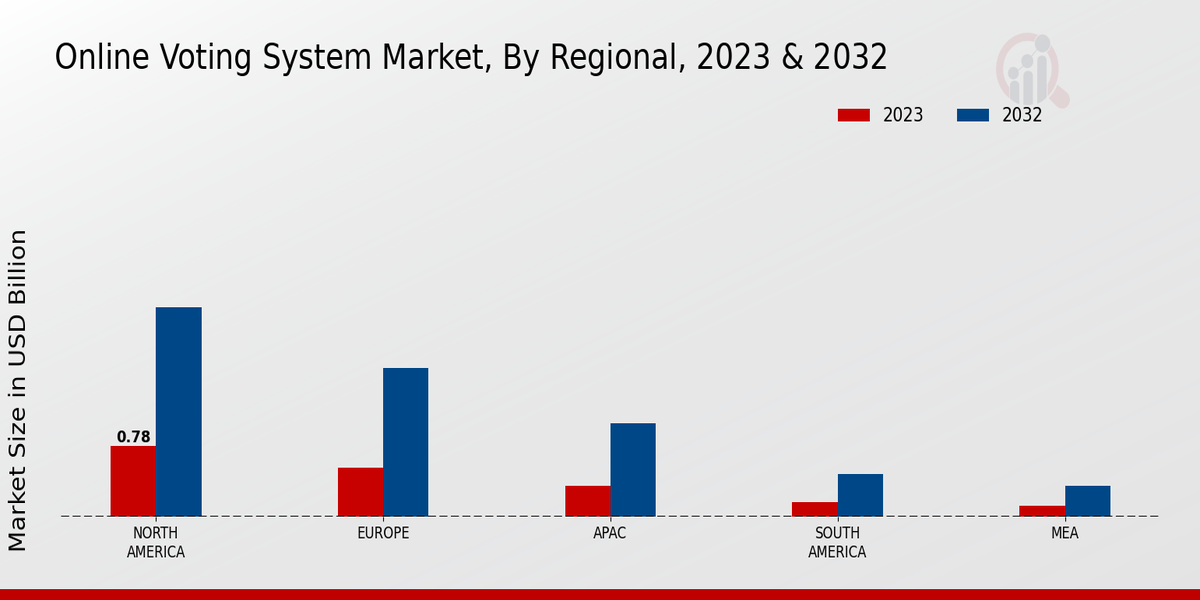Market Growth Projections
The Global Online Voting System Market Industry is projected to experience robust growth in the coming years. With an estimated market value of 2.25 USD Billion in 2024, the industry is set to expand significantly, reaching 9.2 USD Billion by 2035. This growth trajectory reflects a compound annual growth rate (CAGR) of 13.66% from 2025 to 2035. The increasing adoption of online voting systems, driven by technological advancements and a growing emphasis on secure and accessible voting solutions, is likely to propel this market forward. As governments and organizations recognize the benefits of online voting, the industry is poised for substantial transformation.
Rising Awareness of Voter Engagement
Rising awareness of voter engagement is significantly influencing the Global Online Voting System Market Industry. As civic organizations and governments emphasize the importance of participation in democratic processes, online voting emerges as a viable solution to enhance voter turnout. The convenience of online platforms appeals to younger demographics, who are increasingly tech-savvy and prefer digital interactions. This trend is likely to drive the adoption of online voting systems, as they offer a more accessible alternative to traditional voting methods. The growing focus on voter engagement is expected to contribute to the market's expansion, aligning with broader efforts to strengthen democratic participation.
Global Push for Remote Voting Options
The Global Online Voting System Market Industry is witnessing a significant push for remote voting options, driven by the need for accessibility and convenience. Many countries are exploring online voting as a means to facilitate participation among citizens who may face barriers to traditional voting methods, such as those living abroad or with disabilities. This trend is particularly relevant in the context of increasing voter turnout and engagement. By 2035, the market is anticipated to expand to 9.2 USD Billion, indicating a strong preference for flexible voting solutions that cater to diverse populations. The emphasis on remote voting is likely to reshape electoral landscapes globally.
Government Initiatives and Regulations
Government initiatives and regulations are crucial drivers of the Global Online Voting System Market Industry. Many governments are actively promoting the adoption of online voting to enhance electoral efficiency and reduce costs associated with traditional voting methods. Legislative frameworks are being established to ensure the security and integrity of online voting systems. These initiatives not only foster public trust but also encourage technological investments from private sectors. As governments recognize the potential of online voting to streamline electoral processes, the market is poised for substantial growth, further supported by favorable regulatory environments that facilitate innovation and implementation.
Technological Advancements in Digital Voting
Technological advancements play a pivotal role in shaping the Global Online Voting System Market Industry. Innovations such as blockchain technology, biometric authentication, and artificial intelligence are being integrated into online voting systems to enhance security and user experience. These technologies not only streamline the voting process but also provide robust mechanisms for verifying voter identities and ensuring data integrity. As these advancements continue to evolve, they are expected to attract more users and increase the adoption of online voting solutions. The market's growth trajectory, with a projected CAGR of 13.66% from 2025 to 2035, underscores the potential of these technologies to transform electoral processes.
Increasing Demand for Secure Voting Solutions
The Global Online Voting System Market Industry is experiencing a surge in demand for secure and reliable voting solutions. As concerns regarding election integrity and security continue to rise, governments and organizations are increasingly adopting online voting systems that utilize advanced encryption and authentication technologies. This shift is driven by the need to ensure transparency and trust in electoral processes. In 2024, the market is projected to reach 2.25 USD Billion, reflecting a growing recognition of the importance of secure voting mechanisms. The emphasis on security is likely to propel further investments in innovative technologies, thereby enhancing the overall credibility of online voting.






















